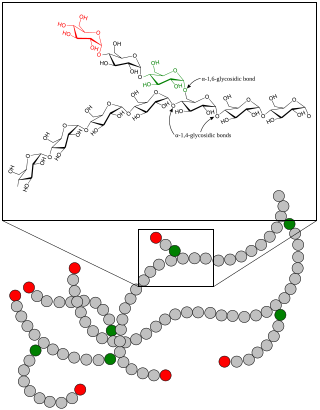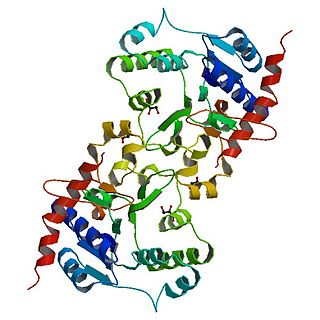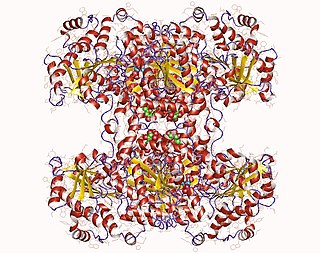Related Research Articles

Polysaccharides, or polycarbohydrates, are the most abundant carbohydrates found in food. They are long-chain polymeric carbohydrates composed of monosaccharide units bound together by glycosidic linkages. This carbohydrate can react with water (hydrolysis) using amylase enzymes as catalyst, which produces constituent sugars. They range in structure from linear to highly branched. Examples include storage polysaccharides such as starch, glycogen and galactogen and structural polysaccharides such as cellulose and chitin.

Glycogen is a multibranched polysaccharide of glucose that serves as a form of energy storage in animals, fungi, and bacteria. It is the main storage form of glucose in the human body.
In polymer science, the polymer chain or simply backbone of a polymer is the main chain of a polymer. Polymers are often classified according to the elements in the main chains. The character of the backbone, i.e. its flexibility, determines the properties of the polymer. For example, in polysiloxanes (silicone), the backbone chain is very flexible, which results in a very low glass transition temperature of −123 °C. The polymers with rigid backbones are prone to crystallization in thin films and in solution. Crystallization in its turn affects the optical properties of the polymers, its optical band gap and electronic levels.

Glycogenolysis is the breakdown of glycogen (n) to glucose-1-phosphate and glycogen (n-1). Glycogen branches are catabolized by the sequential removal of glucose monomers via phosphorolysis, by the enzyme glycogen phosphorylase.

Sialic acids are a class of alpha-keto acid sugars with a nine-carbon backbone. The term "sialic acid" was first introduced by Swedish biochemist Gunnar Blix in 1952. The most common member of this group is N-acetylneuraminic acid found in animals and some prokaryotes.

Glycogenin is an enzyme involved in converting glucose to glycogen. It acts as a primer, by polymerizing the first few glucose molecules, after which other enzymes take over. It is a homodimer of 37-kDa subunits and is classified as a glycosyltransferase.

Glycogen synthase is a key enzyme in glycogenesis, the conversion of glucose into glycogen. It is a glycosyltransferase that catalyses the reaction of UDP-glucose and n to yield UDP and n+1.

The glycogen debranching enzyme, in humans, is the protein encoded by the gene AGL. This enzyme is essential for the breakdown of glycogen, which serves as a store of glucose in the body. It has separate glucosyltransferase and glucosidase activities.

Uridine diphosphate glucose is a nucleotide sugar. It is involved in glycosyltransferase reactions in metabolism.
The enzyme [glycogen-synthase-D] phosphatase ({EC 3.1.3.42) catalyzes the reaction
In enzymology, an alpha-1,4-glucan-protein synthase (ADP-forming) is an enzyme that catalyzes the chemical reaction
In enzymology, an alpha,alpha-trehalose-phosphate synthase (UDP-forming) is an enzyme that catalyzes the chemical reaction
In enzymology, an amylosucrase is an enzyme that catalyzes the chemical reaction

In enzymology, a starch synthase is an enzyme that catalyzes the chemical reaction

Sialic acid-binding Ig-like lectin 12, or Siglec-XII, is a protein that in humans, is encoded by the SIGLEC12 gene.
Ajit Varki is a physician-scientist who is distinguished professor of medicine and cellular and molecular medicine, founding co-director of the Glycobiology Research and Training Center at the University of California, San Diego (UCSD), and founding co-director of the UCSD/Salk Center for Academic Research and Training in Anthropogeny (CARTA). He is also executive editor of the textbook Essentials of Glycobiology and distinguished visiting professor at the Indian Institute of Technology in Madras and the National Center for Biological Sciences in Bangalore. He is a specialist advisor to the Human Gene Nomenclature Committee.
In biochemistry, the term sialome may refer to two distinct concepts:

N-Glycolylneuraminic acid (Neu5Gc) is a sialic acid molecule found in most non-human mammals. Humans cannot synthesize Neu5Gc because the human gene CMAH is irreversibly mutated, though it is found in other apes. The gene CMAH encodes for CMP-N-acetylneuraminic acid hydroxylase, which is the enzyme responsible for CMP-Neu5Gc from CMP-N-acetylneuraminic (CMP-Neu5Ac) acid. This loss of CMAH is estimated to have occurred 2-3 million years ago, just before the emergence of the genus Homo.
Stuart Arthur Kornfeld is a professor of medicine at Washington University in St. Louis and researcher in glycobiology.

Rosalind Hauk Kornfeld (1935–2007) was a scientist at Washington University in St. Louis known for her research determining the structure and formation of oligosaccharides. The Society of Glycobiology annually awards a lifetime achievement award in her honor.
References
- ↑ edited by Ajit Varki ... (2009). Essentials of Glycobiology. Ajit Varki (ed.) (2nd ed.). Cold Spring Harbor Laboratories Press. ISBN 978-0-87969-770-9.
{{cite book}}:|author=has generic name (help)